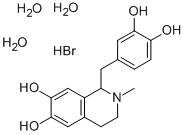Biochemical Engineering
- • Amino Acids and Proteins (221)
- • Nucleic Acid Drugs (18)
- • Enzymes and Coenzymes Drugs (115)
- • Inhibitors (1083)
- • Biological Response Modifiers (15)
- • Fat Medicines (7)
- • Amino Acids and Derivatives (4144)
- • Saccharides (2371)
- • Biochemical Reagents (322)
- • Nucleoside Drugs (346)
- • Condensing Agent (40)
- • Polypeptide (619)
- • Biosynthetic Natural Products (105)
- • Plant Extracts (813)
- • Chinese Herbs (352)
- • Microbiology Reagents (11)
- • Protein Research (34)
- • Lipids (281)
- • Inflammation Mediators (128)
Related News
Sort Chinese Herbs Alphabetically
Chinese Herbs
HOMOARBUTIN
(25712-94-1)-
![HOMOARBUTIN CAS NO 25712-94-1 buy HOMOARBUTIN CAS NO 25712-94-1]()
Industrial Grade, Feed Grade, Food Grade, Pharma Grade / 99%
$11.11/KG EXW
-
![b-D-Glucopyranoside,4-hydroxy-3-methylphenyl buy b-D-Glucopyranoside,4-hydroxy-3-methylphenyl]()
-
![HOMOARBUTIN buy HOMOARBUTIN]()
-
![b-D-Glucopyranoside,4-hydroxy-3-methylphenyl buy b-D-Glucopyranoside,4-hydroxy-3-methylphenyl]()
Industrial Grade / 99%
Request for quotation , get quotes from more suppliers.
-
![rhapontisterone buy rhapontisterone]()
Industrial Grade / 99.0%
-
![rhapontisterone buy rhapontisterone]()
-
![rhapontisterone buy rhapontisterone]()
Industrial Grade / 99%
-
![(2S,3R,5R,9R,10R,11R,13R,17S)-2,3,11,14-tetrahydroxy-10,13-dimethyl-17-[(2R,3R,5S)-2,3,5-trihydroxy-6-methylheptan-2-yl]-2,3,4,5,9,11,12,15,16,17-decahydro-1H-cyclopenta[a]phenanthren-6-one buy (2S,3R,5R,9R,10R,11R,13R,17S)-2,3,11,14-tetrahydroxy-10,13-dimethyl-17-[(2R,3R,5S)-2,3,5-trihydroxy-6-methylheptan-2-yl]-2,3,4,5,9,11,12,15,16,17-decahydro-1H-cyclopenta[a]phenanthren-6-one]()
Request for quotation , get quotes from more suppliers.
-
Industrial Grade / 99%
-
![ALLOISOIMPERATORIN buy ALLOISOIMPERATORIN]()
IndustrialGrade / 99.00%
-
![ALLOISOIMPERATORIN buy ALLOISOIMPERATORIN]()
-
![ALLOISOIMPERATORIN buy ALLOISOIMPERATORIN]()
Request for quotation , get quotes from more suppliers.
-
![VERPROSIDE buy VERPROSIDE]()
Industrial Grade / 99%
-
![VERPROSIDE buy VERPROSIDE]()
-
![VERPROSIDE buy VERPROSIDE]()
-
![VERPROSIDE buy VERPROSIDE]()
Industrial Grade / 99%
Request for quotation , get quotes from more suppliers.
7-O-Methylmorroniside
(41679-97-4)-
![7-O-Methylmorroniside buy 7-O-Methylmorroniside]()
-
![7-O-Methylmorroniside buy 7-O-Methylmorroniside]()
Industrial Grade / 99%
-
![7-O-methylmorroniside buy 7-O-methylmorroniside]()
-
![7-O-Methyl morroniside buy 7-O-Methyl morroniside]()
Request for quotation , get quotes from more suppliers.
Mesaconitine
(2752-64-9)-
![Mesaconitine CAS NO 2752-64-9 buy Mesaconitine CAS NO 2752-64-9]()
Industrial Grade, Feed Grade, Food Grade, Pharma Grade / 99%
$11.11/KG EXW
-
![Mesaconitine buy Mesaconitine]()
-
![Mesaconitine buy Mesaconitine]()
-
![Mesaconitine buy Mesaconitine]()
Request for quotation , get quotes from more suppliers.
-
![1,2,3-Nonadecanetricarboxylicacid, 2-hydroxy- buy 1,2,3-Nonadecanetricarboxylicacid, 2-hydroxy-]()
-
![AGARIC ACID buy AGARIC ACID]()
-
![1,2,3-Nonadecanetricarboxylicacid, 2-hydroxy- buy 1,2,3-Nonadecanetricarboxylicacid, 2-hydroxy-]()
Industrial Grade / 99%
-
![2-hydroxynonadecane-1,2,3-tricarboxylic acid buy 2-hydroxynonadecane-1,2,3-tricarboxylic acid]()
Request for quotation , get quotes from more suppliers.
4H-1-Benzopyran-4-one,2-(4-(beta-D-glucopyranosyloxy)phenyl)-2,3-dihydro-5,7-dihydroxy-,(2S)-
(81202-36-0)-
Industrial Grade / 99%
-
![4H-1-Benzopyran-4-one,2-(4-(beta-D-glucopyranosyloxy)phenyl)-2,3-dihydro-5,7-dihydroxy-,(2S)- buy 4H-1-Benzopyran-4-one,2-(4-(beta-D-glucopyranosyloxy)phenyl)-2,3-dihydro-5,7-dihydroxy-,(2S)-]()
IndustrialGrade / 99%
-
![4H-1-Benzopyran-4-one, 2-(4-(beta-D-glucopyranosyloxy)phenyl)-2,3-dihy dro-5,7-dihydroxy-, (2S)- buy 4H-1-Benzopyran-4-one, 2-(4-(beta-D-glucopyranosyloxy)phenyl)-2,3-dihy dro-5,7-dihydroxy-, (2S)-]()
-
![4H-1-Benzopyran-4-one, 2-(4-(beta-D-glucopyranosyloxy)phenyl)-2,3-dihy dro-5,7-dihydroxy-, (2S)- buy 4H-1-Benzopyran-4-one, 2-(4-(beta-D-glucopyranosyloxy)phenyl)-2,3-dihy dro-5,7-dihydroxy-, (2S)-]()
25kg/Cardboard Drum / 99%
Request for quotation , get quotes from more suppliers.
Glabrene
(60008-03-9)-
![GLABRENE buy GLABRENE]()
Industrial Grade / 99%
-
![GLABRENE buy GLABRENE]()
-
![GLABRENE buy GLABRENE]()
Industrial Grade / 99%
-
![8-(7-hydroxy-2H-chromen-3-yl)-2,2-dimethylchromen-5-ol buy 8-(7-hydroxy-2H-chromen-3-yl)-2,2-dimethylchromen-5-ol]()
Request for quotation , get quotes from more suppliers.
-
![DL-LAUDANOSOLINE HYDROBROMIDE TRIHYDRATE buy DL-LAUDANOSOLINE HYDROBROMIDE TRIHYDRATE]()
- / 95%
-
![DL-LAUDANOSOLINE HYDROBROMIDE TRIHYDRATE buy DL-LAUDANOSOLINE HYDROBROMIDE TRIHYDRATE]()
-
![DL-LAUDANOSOLINE HYDROBROMIDE TRIHYDRATE buy DL-LAUDANOSOLINE HYDROBROMIDE TRIHYDRATE]()
Industrial Grade / 99%
-
![DL-LAUDANOSOLINE HYDROBROMIDE TRIHYDRATE buy DL-LAUDANOSOLINE HYDROBROMIDE TRIHYDRATE]()
Request for quotation , get quotes from more suppliers.





























